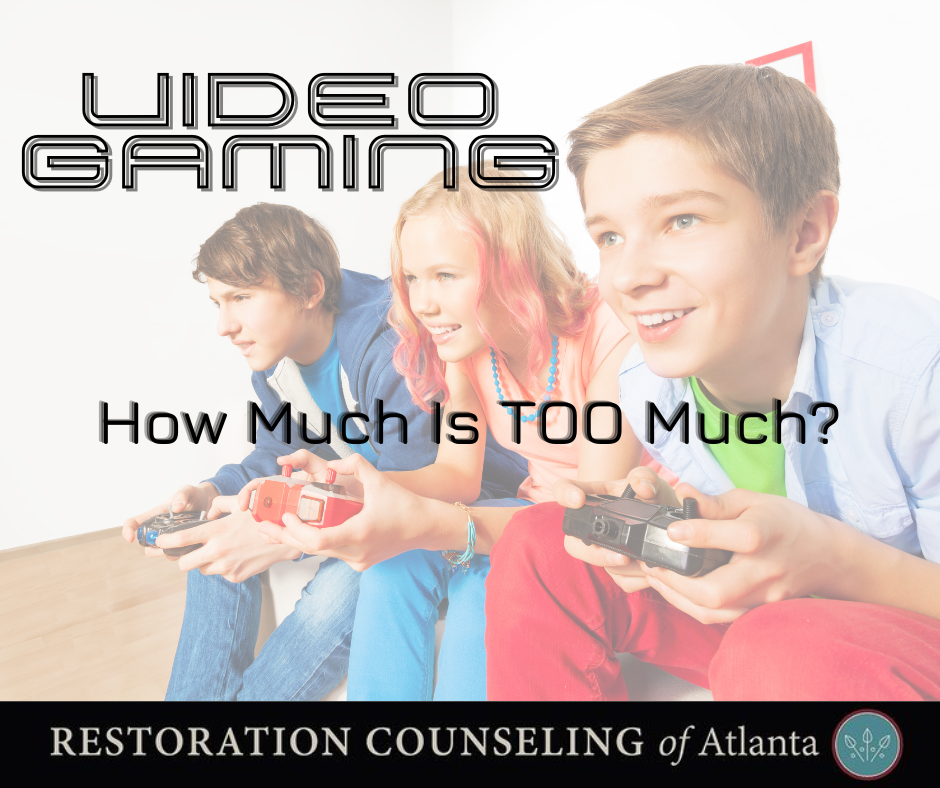Videogaming can certainly be a problem. The answer to the question of how much is too much is not a simple one. We hear this question often within family and individual therapy sessions.
Why ask the question?
The proliferation, expansion, and easy access to technology have significantly impacted our culture. We see increased violence, isolation, depression, and deaths, which may be traced back to videogaming. We see how the social restrictions of COVID-19 created the need to connect more often through media, which opened the door to feeling compelled to be immersed in a virtual world. The International Classification of Diseases 11 (ICD-11) [1] acknowledges that addiction to internet gaming exists, but The Diagnostic Statistical Manual for Mental Disorders (DSM-5) says further research is needed.
Since 2012, researchers have increasingly focused on trying to quantify how and when videogaming becomes a problem. How and when does it turn from being healthy to becoming an abusive and ultimately addictive behavior? The question is similar to asking how much food is too much or asking the same question about friendships, work, time on your phone, etc. The answer is – it depends.
Do I have a problem?
Specific markers indicate when a person is using video games healthily and when there is a risk of abusing gaming privileges and becoming addicted. According to the American Psychiatric Association, someone is at risk for developing Internet Gaming Disorder (IGD) if they experience at least five of the following nine criteria during a 12-month period[2]:
- gaming preoccupation
- withdrawal
- tolerance
- loss of interest in other activities
- downplaying or minimizing time spent playing videogames
- loss of relationships, educational, or career opportunities
- gaming to escape or relieve anxiety, guilt, or other negative mood states
- failure to control time spent playing videogames
- continued gaming despite psychosocial problems.
What do I look for?
If someone regularly;
- fails to fulfill their daily responsibilities,
- does not get enough sleep,
- becomes irritable due to not playing video games,
- is not making real-life friends,
- is not exercising or getting outside, and
- can’t stop videogaming (despite negative consequences),
then, abuse is prevalent and could develop into an addiction.
FACTS AND EFFECTS OF VIDEOGAMING
Researchers have found that videogaming that becomes compulsive depends on several external and internal factors that can eventually lead to addiction.
Contributing factors may include:
- a moderate score on the Adverse Childhood Experiences trauma assessment
- fatherlessness
- neglect and lack of parental attunement
- violent family system or community
- characteristics of anger dysregulation
- the amount of time spent videogaming
- certain types of video games played that are violent and sexualized
Most of these risk factors are outside of a person’s control; however, they can control their response toward themselves and video games.
Negative Facts & Effects of Videogame Use
According to a poll by the Kaiser Foundation, children ages 8-18 average around 8 hours weekly, but it is not uncommon for them to play 20-40 hours weekly. Ages 11–14 had the most hours played, with boys outplaying girls by more than 2.5:1 hours. Another study suggested that 99% of boys and 94% of girls have played video games.[3]
- In a meta-analysis study, 2 billion people play video games, with 3.05% falling under the classification of IGD (over 60 million people who struggle with IGD)[4]
- In a longitudinal study, adolescents who played video games were three times more likely to be diagnosed with ADD or ADHD. This is due to the fact that many video games promote constant reactivity (which are typically first-person shooter games). [5]
- “In a study of 1491 youth between 10 and 19, gamers spent 30 percent less time reading and 34 percent less time doing homework.” This leads to poor school performance due to time displacement, attention deficit, and preoccupation.[6]
- Studies also showed some of these youth also overplayed video games to feel a sense of accomplishment and mastery to compensate for the lack of performance in school.
- “Conservative estimates are that media violence may be causing 10% of real-life violence – not the leading cause by any means, but an unhealthy chunk that we could do something about if we chose to (Strasburger et al., 2009; Comstock & Strasburger, 1990)”.[7]
- According to meta-analysis and longitudinal studies, the Supreme Court, American Psychological Association, and the American Academy of Pediatrics agree that real and fictitious violent video games are risk factors linked to aggression and violence. [8] And the effects of video games that depicted violence and sexualization created desensitization and normalization of aggressive, harassing, and violent thoughts and behaviors. Gamers may have a general belief that it all goes unpunished and rewarded. Unrealistic expectations of the consequences for the victim and perpetrator develop.
- Extreme but public examples are William and Joshua Buckner, Devin Moore, Behring Breivik, and an 18-year-old in Thailand. They attribute video games such as Modern Warfare 2, World of Warcraft, and Grand Theft Auto to their decisions to participate in bombings, stabbings, and shootings.[9]
- Excessive video game use is linked to obesity, depression, and dysregulation; These lead to anger and anxiety problems, slowed prefrontal cortex development[10] , and an inability to make responsible and aware decisions. These deficiencies may escalate to social anxiety, isolation, addiction, and withdrawal symptoms.[11]
Positive Facts & Effects of Videogame Use
- A study showed that Air Force cadets who played flight video games to help their actual flight performance outperformed cadets who didn’t play flying video games.[12]
- “In a longitudinal study of Japanese children in grades 5, 8 and 11, exposure to pro-social video games at the start of the study was linked to increased pro-social behavior some months later”. [13]
- Video games that don’t require constant reactivity but instead require participation, focused tasks, and interactivity provide creativity and innovation and improve school performance through memory retention.[14]
- Brain scans of 260 children showed children who played video games for an hour or more had more white matter in their basal ganglia, which helps improve neuro connectivity within the brain. These connections increase reaction times. However, two hours or more had minor additional motor improvements.[15]
- People gravitate toward heroic, attractive, and realistic character development due to a desire to relate to these types.[16]
- Surgeons, drone pilots, pilots, and teachers use video games to help enhance their hand-eye coordination skill set and visual skills. Repetition enhances mirror neurons and spatial cognition through interactive thinking with pro-social games.
- Video games provide a sense of mastery, accomplishment, and stress release. This occurs through connecting with others through the medium of gaming, which helps with social anxiety or autism.[17]
- Videogaming can lead to people meeting and connecting in person and be a conduit for community. For example, a pastor would hold church services after Rocket League, and friends online in America would meet friends in Europe.
So, how much is too much videogaming?
Overall, the American Psychiatry Association recommends playing video games that are not constantly reactive and violent but are pro-social, interactive, and task-focused. They recommend playing for one hour a day and no more than two hours per day on the weekend. This equates to nine hours weekly. However, other research shows that the older the person is, the more hours they can effectively handle, depending on the video game being played. Although more research is being developed, the consensus is that there is a need to have gaps for balance. Otherwise, the constancy of gaming can lead to abuse.[18]
What should I do?
Assess yourself.
If you are an avid video gamer, I invite you to assess yourself without shame and in brutal honesty. It is wise to determine whether you are in excess or balance. Are you in control or unable to stop more times than not? Are you in isolation, or are meeting with community in-person?
Get support.
I am here to support you if you believe you are gaming in excess to where it is compulsive or possibly an addiction. Together we can build an awareness of the root of compulsive gaming and move toward healing and gain the freedom to live the life you desire.
Be a proactive parent.
If you’re a parent, I invite you to relieve pressure on yourself by empowering your child. You can help them build awareness by “having the consequences be put on themselves” so they can truly learn how to live their life well. Often, I coach parents by giving them two timers, one with 10 minutes left and one where time is up. If they don’t turn off the video game when the last timer goes off, then videogaming is revoked for days or a week, depending on the repeat offense.
Some parents have found it helpful to allow their children to play for an hour to decompress after a long school day. They may then earn another when they have met all their responsibilities. Other parents stipulate that the child must first meet their responsibilities before playing. Others establish a plan that as long as responsibilities and activities are met without constant reminders by the parent, then videogame use doesn’t have to be monitored much.
Determine your position.
If you are a parent and feel helpless to guide your child well, I encourage you to assess your values and boundaries. Determine your position on certain types of games. Then share with your child, from your heart, your negotiables and non-negotiables. Get your child’s thoughts to strike a compromise, so they feel empowered. If you cannot reach an agreement or resolve a conflict, I am here to support you.
Overall, I compare video games to certain types of food. It is good to have more of some, less of others, and avoid some altogether. Nonetheless, video games can provide an opportunity for you to engage in your child’s imagination and understand what makes them come alive. It can help you have a further conversation to help them regulate what they watch and hear and to help them make an empowered decision.
Create balance.
Lastly, I recommend being mindful of balancing media time by playing video games with your child often and working together by integrating house projects[19], and having family and friends do something different or adventurous together. Regardless of your child’s age, I recommend having accountability software such as Ever Accountable or Accountable2You on all electronic devices. I also recommend not having TVs or gaming consoles in bedrooms at night due to the conscious/unconscious motivation to want to escape, numb out, find entertainment, and feed entitlement, etc.
 Written by:
Written by:
Micah Mabe, MA MFT, APC
Roswell Location
micah@restorationcounselingatl.com, ext. 158
Micah comes from a Christian background and enjoys working with adolescents and families and couples. His focus is coming alongside families, adolescents, and teenagers who desire help and resolution. His other focus is helping couples who want to understand better and love their partner to enhance their marriage. He also helps couples in conflictual relationships struggling with disconnection and isolation.
Resources
- Hooked on Games: The Lure and Cost of Video Game and Internet Addiction, by Andrew Doan
- Irresistible: The Rise of Addictive Technology, by Adam Atler
- 12 Steps for Online Gamers Anonymous and Family/Friends
- Intensive Outpatient or Residential Treatment Centers such as Cottonwood in Tuscon
[1] World Health Organization. (n.d.). 6C51 Gaming disorder. World Health Organization. Retrieved July 27, 2022, from https://icd.who.int/browse11/l-m/en#/http%253a%252f%252fid.who.int%252ficd%252fentity%252f1448597234
[2] Nasution, F. A., Effendy, E., & Amin, M. M. (2019, August 27). Internet gaming disorder (IGD): A case report of social anxiety. Open access Macedonian journal of medical sciences. Retrieved July 27, 2022, from https://www.ncbi.nlm.nih.gov/pmc/articles/PMC6876823/
[3] Chapter in W. Warburton & D. Braunstein (Eds.). (2012). Growing Up Fast and Furious: Reviewing the Impacts of Violent and Sexualised Media on Children, (pp. 56-84). Annandale, NSW, Australia: The Federation Press.
[4] Adair, C. (2022, July 18). Video game addiction statistics 2022 – how many addicted gamers are there? Game Quitters. Retrieved July 27, 2022, from https://gamequitters.com/video-game-addiction-statistics/
[5] W. Warburton & D. Braunstein (Eds.). (2012). Growing Up Fast and Furious: Reviewing the Impacts of Violent and Sexualised Media on Children, pg. 60. Annandale, NSW, Australia: The Federation Press.
[6] W. Warburton & D. Braunstein (Eds.). (2012). Growing Up Fast and Furious: Reviewing the Impacts of Violent and Sexualised Media on Children, pg. 61. Annandale, NSW, Australia: The Federation Press.
[7] W. Warburton & D. Braunstein (Eds.). (2012). Growing Up Fast and Furious: Reviewing the Impacts of Violent and Sexualised Media on Children, pg. 63. Annandale, NSW, Australia: The Federation Press.
[8] W. Warburton & D. Braunstein (Eds.). (2012). Growing Up Fast and Furious: Reviewing the Impacts of Violent and Sexualised Media on Children, pg. 65. Annandale, NSW, Australia: The Federation Press.
[9] W. Warburton & D. Braunstein (Eds.). (2012). Growing Up Fast and Furious: Reviewing the Impacts of Violent and Sexualised Media on Children, pg. 70. Annandale, NSW, Australia: The Federation Press.
[10] Fauth-Bühler, M., & Mann, K. (2015). Neurobiological correlates of internet gaming disorder: Similarities to pathological gambling. Addictive Behaviors. Retrieved July 27, 2022, from https://www.sciencedirect.com/science/article/abs/pii/S0306460315300551
[11] Grinspoon, P. (2020). The health effects of too much gaming. Harvard Health. Retrieved July 27, 2022, from https://www.health.harvard.edu/blog/the-health-effects-of-too-much-gaming-2020122221645
[12] W. Warburton & D. Braunstein (Eds.). (2012). Growing Up Fast and Furious: Reviewing the Impacts of Violent and Sexualised Media on Children, pg. 54. Annandale, NSW, Australia: The Federation Press.
[13] W. Warburton & D. Braunstein (Eds.). (2012). Growing Up Fast and Furious: Reviewing the Impacts of Violent and Sexualised Media on Children, pg. 58. Annandale, NSW, Australia: The Federation Press.
[14] W. Warburton & D. Braunstein (Eds.). (2012). Growing Up Fast and Furious: Reviewing the Impacts of Violent and Sexualised Media on Children, pg. 58. Annandale, NSW, Australia: The Federation Press.
[15] Mozes, A. (2016). How much video gaming is too much for kids? WebMD. Retrieved July 27, 2022, from https://www.webmd.com/parenting/news/20160927/video-gaming-kids
[16] W. Warburton & D. Braunstein (Eds.). (2012). Growing Up Fast and Furious: Reviewing the Impacts of Violent and Sexualised Media on Children, pg. 70. Annandale, NSW, Australia: The Federation Press.
[17] Grinspoon, P. (2020). The health effects of too much gaming. Harvard Health. Retrieved July 27, 2022, from https://www.health.harvard.edu/blog/the-health-effects-of-too-much-gaming-2020122221645
[18] Strasburger, V. C., Hogan, M. J., Mulligan, D. A., Ameenuddin, N., Christakis, D. A., Cross, C., Fagbuyi, D. B., Hill, D. L., Levine, A. E., McCarthy, C., Moreno, M. A., & Swanson, W. S. L. (2013, November). Children, adolescents, and the media. American Academy of Pediatrics. Retrieved July 27, 2022, from https://publications.aap.org/pediatrics/article/132/5/958/31699/Children-Adolescents-and-the-Media?autologincheck=redirected
[19] Arsenault , L. (2017). Research on household chores. https://www.apadivisions.org. Retrieved July 27, 2022, from https://www.apadivisions.org/division-35/news-events/news/household-chores

